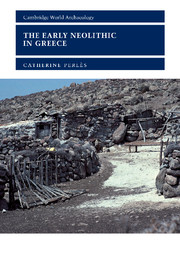Book contents
- Frontmatter
- Contents
- List of figures
- List of tables
- Acknowledgements
- Introduction
- 1 The land and its resources: the geographic context
- 2 The Mesolithic background
- 3 The introduction of farming: local processes, diffusion or colonization?
- 4 Foreign colonists: where from?
- 5 The earliest Neolithic deposits: ‘aceramic’, ‘pre-pottery’ or ‘ceramic’?
- 6 The spread of the Early Neolithic in Greece: chronological and geographical aspects
- 7 A case study in Early Neolithic settlement patterns: eastern Thessaly
- 8 Early Neolithic subsistence economy: the domestic and the wild
- 9 The Early Neolithic village
- 10 Craft specialization: the contrasting cases of chipped-stone tools, pottery and ornaments
- 11 A variety of daily crafts
- 12 Ritual interaction? The miniature world of ‘dolls or deities’
- 13 Interacting with the dead: from the disposal of the body to funerary rituals
- 14 Interactions among the living
- Conclusion
- Bibliography
- Index
1 - The land and its resources: the geographic context
Published online by Cambridge University Press: 18 December 2009
- Frontmatter
- Contents
- List of figures
- List of tables
- Acknowledgements
- Introduction
- 1 The land and its resources: the geographic context
- 2 The Mesolithic background
- 3 The introduction of farming: local processes, diffusion or colonization?
- 4 Foreign colonists: where from?
- 5 The earliest Neolithic deposits: ‘aceramic’, ‘pre-pottery’ or ‘ceramic’?
- 6 The spread of the Early Neolithic in Greece: chronological and geographical aspects
- 7 A case study in Early Neolithic settlement patterns: eastern Thessaly
- 8 Early Neolithic subsistence economy: the domestic and the wild
- 9 The Early Neolithic village
- 10 Craft specialization: the contrasting cases of chipped-stone tools, pottery and ornaments
- 11 A variety of daily crafts
- 12 Ritual interaction? The miniature world of ‘dolls or deities’
- 13 Interacting with the dead: from the disposal of the body to funerary rituals
- 14 Interactions among the living
- Conclusion
- Bibliography
- Index
Summary
The natural features of Greece, its climate, topography, water resources and soils, had decisive effects on the Neolithic economy and settlement patterns. They define several distinct provinces, characterized by different historical dynamics throughout the Neolithic and early Bronze Age, whose roots can be traced within the Early Neolithic.
Topography
Paramount amongst those factors is topography, for its impact on the climate and means of communication. The rugged topography of mainland Greece derives from the Alpine orogenic phase and the subsequent epi-orogenic subsidence accidents (Bintliff 1977; Higgins and Higgins 1996; Jacobshagen 1986). The main topographic features are related to a system of ancient sub-marine ridges and furrows of predominant NW/SE orientation. Pelagic and neritic sediments accumulated during the Mesosoic subsidence phase, until the start of the Alpine orogenic phase during the mid-Cretaceous. The latter took place progressively, in a wave-like progression from east to west, uplifting first the continental Hercynian bedrock – the Rhodopes and part of the Pelagonian Zone, with Mounts Ossa and Mavrovouni – then the massive Mesosoic limestones. Important subsidence basins then formed during the epi-orogenic phase, in direct relation with the NW/SE ridge and furrow structure: the West Macedonian Plain (the old Vardar furrow), the Thessalian Plain, the Saronic Gulf and the Kopaïs Basin (Sub-Pelagonian Intermediate Zone), the lowlands of Elis and Messenia. Other subsidence basins have different directions (compare the Gulf of Corinth) and result from still active tectonic movements in this sensitive area at the junction of the African and European plates.
- Type
- Chapter
- Information
- The Early Neolithic in GreeceThe First Farming Communities in Europe, pp. 9 - 19Publisher: Cambridge University PressPrint publication year: 2001



